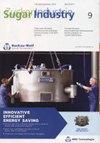Evaluation of a neonicotinoid alternative to phorate for the management of soil insects in Florida sugarcane
IF 0.2
4区 农林科学
Q4 FOOD SCIENCE & TECHNOLOGY
引用次数: 0
Abstract
Wireworms (Coleoptera: Elateridae) are the main soil insect pests of sugarcane (Saccharum spp. hybrids) in Florida. Melanotus communis (Gyllenhal) is the most abundant wireworm in Florida sugarcane fields, reducing stalk populations by feeding on buds of sugarcane seed pieces and on young sugarcane plants. At-planting use of the organophosphate insecticide phorate is the main wireworm management tactic in Florida; however, phorate is a hazardous and relatively expensive insecticide. Thiamethoxam is a neonicotinoid insecticide that has potential to become registered for use on sugarcane in the United States. Previous studies suggested that thiamethoxam decreases wireworm injury to sugarcane seed pieces but does not increase wireworm mortality. The present study conducted between 2018 and 2022 aimed to comprehensively evaluate thiamethoxam for wireworm control under laboratory, outdoor, and field conditions. In two laboratory bioassays, M. communis mortality associated with thiamethoxam (3–20%) was not different than mortality for the non-treated check (0–7%), whereas mortality associated with phorate attained 93–100%. In three large container experiments conducted outdoors with controlled M. communis infestations, thiamethoxam and phorate generally protected young sugarcane plant populations at comparable levels. Insecticide efficacy was mainly associated with the protection of seed-piece buds. However, the number of recovered live wireworms was 2.7–8.0 times greater in thiamethoxam treatments than in phorate treatments. In three field experiments, young sugarcane plant populations in thiamethoxam- and phorate-treated plots were not different than those in non-treated plots. However, the at-planting application of thiamethoxam decreased the number of sugarcane thrips, Fulmekiola serrata (Kobus), by 67–89% in two experiments with thrips infestations 12 weeks after planting. Although the evaluation of insecticide efficacy under natural wireworm infestations was inconclusive, this study confirmed that thiamethoxam should be considered as an alternative to phorate if registered. However, the long-term effects of low wireworm mortality associated with thiamethoxam use should be studied.新烟碱类替代磷酸盐对佛罗里达州甘蔗土壤昆虫管理的评价
线虫(鞘翅目:线虫科)是美国佛罗里达州甘蔗(Saccharum spp.杂种)的主要土壤害虫。黑线虫(Melanotus communis, Gyllenhal)是佛罗里达州甘蔗田数量最多的线虫,它以甘蔗种子片的芽和甘蔗幼苗为食,从而减少甘蔗茎的数量。在佛罗里达州种植时使用有机磷杀虫剂是主要的线虫管理策略;然而,磷酸盐是一种危险且相对昂贵的杀虫剂。噻虫嗪是一种新烟碱类杀虫剂,有可能在美国注册用于甘蔗。以前的研究表明噻虫嗪可以减少线虫对甘蔗种片的伤害,但不会增加线虫的死亡率。本研究于2018年至2022年期间进行,旨在综合评价噻虫嗪在实验室、室外和现场条件下控制线虫的效果。在两项实验室生物测定中,与噻虫嗪(3-20%)相关的社区M. 死亡率与未处理检查的死亡率(0-7%)没有区别,而与磷酸盐相关的死亡率达到93-100%。在室外进行的三个大型容器试验中,在控制了 m.s ccommunis虫害的情况下,噻虫嗪和磷酸酯一般在相当水平上保护了甘蔗幼苗种群。杀虫效果主要与保护种片芽有关。然而,噻虫嗪处理的活线虫数量是磷酯处理的2.7-8.0倍。在3个大田试验中,施用噻虫嗪和磷肥的地块与未施用的地块相比,甘蔗幼苗数量没有显著差异。然而,在种植后12周的两项试验中,施用噻虫胺可使甘蔗蓟马(Fulmekiola serrata, Kobus)的数量减少67-89%。虽然对天然线虫侵害下的杀虫剂药效评价尚无定论,但本研究证实,如果登记,噻虫嗪应被视为磷盐的替代品。然而,应研究与噻虫嗪使用相关的低线虫死亡率的长期影响。
本文章由计算机程序翻译,如有差异,请以英文原文为准。
求助全文
约1分钟内获得全文
求助全文
来源期刊

Sugar Industry-Zuckerindustrie
工程技术-食品科技
CiteScore
0.50
自引率
50.00%
发文量
22
审稿时长
18-36 weeks
期刊介绍:
Sugar Industry / Zuckerindustrie accepts original papers (research reports), review articles, and short communications on all the aspects implied by the journals title and subtitle.
 求助内容:
求助内容: 应助结果提醒方式:
应助结果提醒方式:


